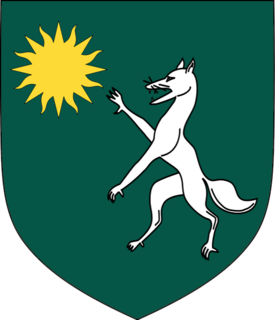Tipraiti Tireach (136 — 187) spelled with numerous different variations such as Tibraite, Tipraite, Tiobraide, Thilbruidhe and Tiobradhe, was a Celtic legendary King of Ulster according to the Annals of the Four Masters . [1] The Annals also describes Tipraiti Tireach as the founder of Dál nAraidi. [2] He was the son of Mal, a High King of Ireland and a descendant of hero Conall Cernach. Part of the wide Milesian race with a lineage that traces back directly to Míl Espáine, whose son tradition holds, went to Ireland from Hispania in the Iberian Peninsula as part of the "Ulster Cycle". [3]

The Annals of the Kingdom of Ireland or the Annals of the Four Masters are chronicles of medieval Irish history. The entries span from the Deluge, dated as 2,242 years after creation to AD 1616.

Dál nAraidi or Dál Araide was a Cruthin kingdom, or possibly a confederation of Cruthin tribes, in north-eastern Ireland during the Middle Ages. It was part of the over-kingdom of Ulaid, and its kings often contended with the Dál Fiatach for the over-kingship of the province. At its greatest extent, the borders of Dál nAraidi roughly match those of County Antrim, and they seem to occupy the same area as the earlier Robogdii of Ptolemy's Geography, a region shared with Dál Riata. Their capital was Ráth Mór outside Antrim, and their eponymous ancestor is claimed as being Fiachu Araide.
Mal, son of Rochraide, a descendant of the legendary hero Conall Cernach, was, according to medieval Irish legend and historical tradition, a king of the Ulaid and later a High King of Ireland. He took the High Kingship after he killed Tuathal Techtmar at Mag Line, and ruled for four years, at the end of which he was killed by Tuathal's son Fedlimid Rechtmar. The Lebor Gabála Érenn synchronises his reign with that of the Roman emperor Antoninus Pius (138–161). The chronology of Geoffrey Keating's Foras Feasa ar Éirinn dates his reign to 100–104, that of the Annals of the Four Masters to 106–110. His son was Tipraiti Tireach
The Lebor Gabála and the Annals say Tipraiti Tireach defeated and slew Conn of the Hundred Battles, the High King of Ireland for thirty-five years, at the Battle of Tuath Amrois. Keating says Tipraiti sent fifty warriors dressed as women from Emain Macha to kill him at Tara. [4]
Conn Cétchathach, son of Fedlimid Rechtmar, was, according to medieval Irish legendary and annalistic sources, a High King of Ireland, and the ancestor of the Connachta, and, through his descendant Niall Noígiallach, the Uí Néill dynasties, which dominated Ireland in the early Middle Ages, and their descendants.

The High Kings of Ireland were sometimes historical and sometimes legendary figures who had, or who are claimed to have had, lordship over the whole of Ireland.
Seathrún Céitinn was a 17th-century historian. He was born in County Tipperary, Ireland, and is buried in Tubrid Graveyard in the parish of Ballylooby-Duhill. He became an Irish Catholic priest and a poet.



